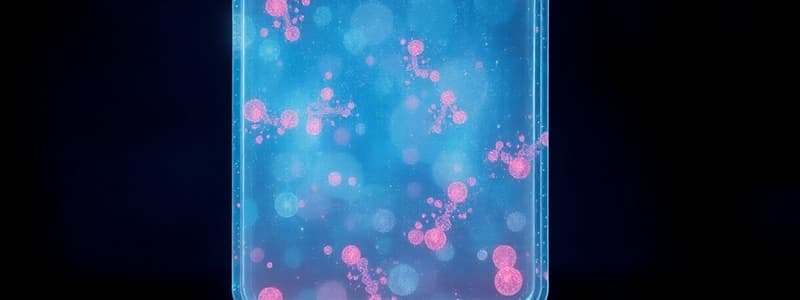Podcast
Questions and Answers
Given the formula for electrophoretic mobility ($\mu = \frac{v}{E}$), which of the following changes would directly decrease electrophoretic mobility?
Given the formula for electrophoretic mobility ($\mu = \frac{v}{E}$), which of the following changes would directly decrease electrophoretic mobility?
- Decreasing the velocity of the particle (v). (correct)
- Maintaining the same velocity while decreasing the electric field.
- Increasing the velocity of the particle (v).
- Increasing the voltage applied (E).
In agarose gel electrophoresis, what is the primary role of the running buffer?
In agarose gel electrophoresis, what is the primary role of the running buffer?
- To increase the pore size of the gel for faster migration of large molecules.
- To carry the current and maintain a constant pH, protecting the samples. (correct)
- To provide a visual aid for tracking the migration of molecules.
- To denature the DNA samples for better migration.
What primarily determines the separation range (in base pairs) of DNA fragments in agarose gel electrophoresis?
What primarily determines the separation range (in base pairs) of DNA fragments in agarose gel electrophoresis?
- The voltage applied during electrophoresis.
- The type of loading buffer used.
- The composition of the running buffer.
- The agarose concentration of the gel. (correct)
Which of the following is the most accurate description of the function of denaturing agents, such as formamide or urea, in electrophoresis?
Which of the following is the most accurate description of the function of denaturing agents, such as formamide or urea, in electrophoresis?
What is the purpose of including density agents like Ficoll or glycerol in the loading buffer before loading samples into the wells of an agarose gel?
What is the purpose of including density agents like Ficoll or glycerol in the loading buffer before loading samples into the wells of an agarose gel?
Why is it crucial to avoid piercing the gel completely when loading samples into the wells of an agarose gel?
Why is it crucial to avoid piercing the gel completely when loading samples into the wells of an agarose gel?
Which of the following best describes why smaller molecules travel farther through an agarose gel during electrophoresis compared to larger molecules?
Which of the following best describes why smaller molecules travel farther through an agarose gel during electrophoresis compared to larger molecules?
Why does increasing the buffer concentration in agarose gel electrophoresis lead to greater heat generation at a given voltage?
Why does increasing the buffer concentration in agarose gel electrophoresis lead to greater heat generation at a given voltage?
In the context of agarose gel electrophoresis, what is the significance of the Henderson-Hasselbalch equation?
In the context of agarose gel electrophoresis, what is the significance of the Henderson-Hasselbalch equation?
Which of the following is a critical distinction between SYBR Green I and SYBR Green II in the context of nucleic acid staining?
Which of the following is a critical distinction between SYBR Green I and SYBR Green II in the context of nucleic acid staining?
Flashcards
Electrophoresis
Electrophoresis
The movement of dispersed, charged particles in a fluid under a uniform electric field. Used to separate DNA, RNA, or proteins based on size and charge.
Electrophoretic Mobility (μ)
Electrophoretic Mobility (μ)
A measure of how a charged particle moves in an electric field. It's the solute's response to an applied electric field.
Net Charge (Electrophoresis)
Net Charge (Electrophoresis)
Charges will migrate to their opposite pole: Negative charges move toward positive, and positive charges move toward negative.
Molecule Size (Electrophoresis)
Molecule Size (Electrophoresis)
Signup and view all the flashcards
Running Buffer (Electrophoresis)
Running Buffer (Electrophoresis)
Signup and view all the flashcards
Buffer Additives (Electrophoresis)
Buffer Additives (Electrophoresis)
Signup and view all the flashcards
Loading Buffer (Electrophoresis)
Loading Buffer (Electrophoresis)
Signup and view all the flashcards
Electrophoresis Equipment
Electrophoresis Equipment
Signup and view all the flashcards
Gel Dyeing
Gel Dyeing
Signup and view all the flashcards
SYBR Green
SYBR Green
Signup and view all the flashcards
Study Notes
Electrophoresis Principle
- Electrophoresis involves ELECTRO (electric field) and PHORESIS (migration).
- Most biomolecules have electrical charges
- It is the movement of charged particles in a fluid under a uniform electric field.
- Important for separating DNA, RNA, or proteins based on size and charge.
Factors Affecting Age
- Net charge influences migration towards the opposite pole.
- Smaller molecules travel farther than larger ones.
- Denatured DNA migrates predictably by size
- Applied voltage is governed by the formula V=IR, where V is voltage (V), I is current (A), and R is resistance (Ω).
- Buffer choice impacts electrophoretic mobility.
- Gel pore size affects movement of macromolecules.
Components of Agarose Gel
- Agarose gel uses a sulfonated polysaccharide polymer from seaweed.
- It's a linear polymer of agarobiose
- Agarobiose includes 1,3-linked-β-D-galactopyranose and 1,4-linked-3,6-anhydro-α-L-galactopyranose
- Agarobiose comprises repeating units of D-galactose and 3,6-anhydro-L-galactopyranose with 1-4 linkages.
- The process uses dried powder dissolved in hot running buffer, cooled to 55-65°C, then poured into a casting tray with a comb to form wells.
- A comb-molder gives the gel its comb-like appearance.
- The gel solidifies at approximately 40°C.
- Higher agarose concentration results in smaller pore sizes.
Buffers during Electrophoresis
- Higher conductivity can lead to increased heat, addressed by using higher buffer concentrations at lower voltages.
- Tris Acetate EDTA (TAE) is most popular for DNA electrophoresis because DNA migrates faster and is more stable,
- Tris borate EDTA (TBE) has greater buffering capacity, but stock solutions may precipitate, leading to distorted migration patterns
- Denaturing agents break H-bonds in nucleic acids
- Formamide and Urea are examples of denaturing agents that result in predictable migration
- Loading buffer includes dye and a density agent.
- Density agents increase sample density with Ficoll, sucrose, or glycerol
- Tracking dyes such as bromophenol blue are used to monitor migration.
Equipment
- Agarose gels run horizontally in acrylic containers.
- Electrodes in the gel box connect to a power supply.
Gel Loading
- The gel should be submerged in the running buffer, filling both compartments
- Following dilution of samples in loading buffer, load carefully into the well.
- Micropipette plunger should be depressed before loading and release after removing the tip
- The tip must be within the well while loading.
- Care must be taken to avoid piercing the gel.
Detection Systems
- After running electrophoresis, dyes that associate with nucleic acids are used to visualize bands.
- Ethidium bromide is an intercalating agent, emits orange light at 590 nm, and is highly carcinogenic.
- SYBR Green I is for double-stranded DNA in rt-PCR.
- SYBR Green II is for single-stranded DNA or RNA staining.
- SYBR Gold can be used for both DNA and RNA staining.
- SYBR Safe is a non-hazardous SYBR Green variant.
- Gel Red is an intercalating agent that is more sensitive than EtBr, and can be added to the gel mix.
- Silver stain is non-toxic and the most sensitive stain for protein analysis.
Studying That Suits You
Use AI to generate personalized quizzes and flashcards to suit your learning preferences.



